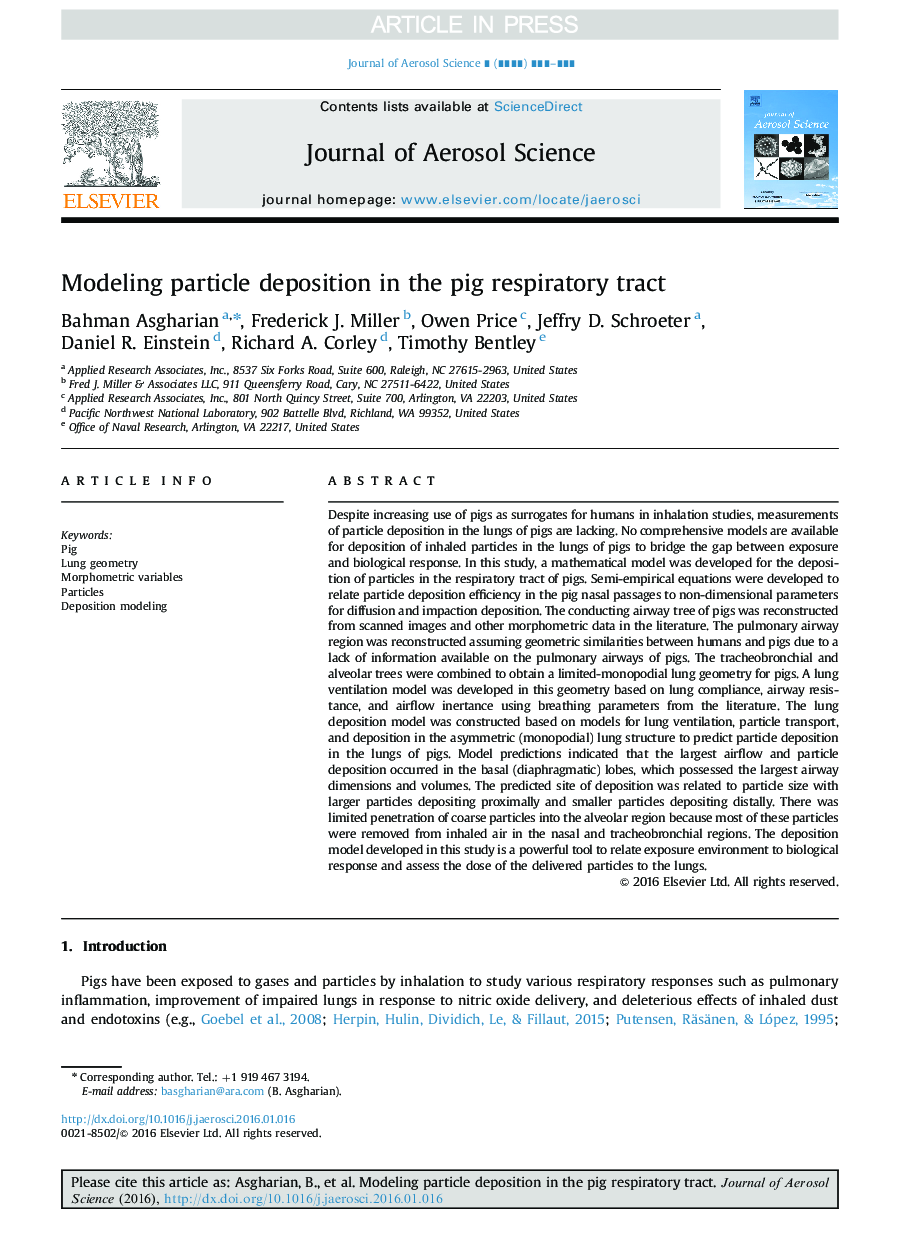| کد مقاله | کد نشریه | سال انتشار | مقاله انگلیسی | نسخه تمام متن |
|---|---|---|---|---|
| 6344342 | 1620724 | 2016 | 18 صفحه PDF | دانلود رایگان |
عنوان انگلیسی مقاله ISI
Modeling particle deposition in the pig respiratory tract
ترجمه فارسی عنوان
مدل سازی رسوب ذرات در دستگاه تنفسی خوک
دانلود مقاله + سفارش ترجمه
دانلود مقاله ISI انگلیسی
رایگان برای ایرانیان
کلمات کلیدی
خوک، هندسه ریه، متغیرهای مورفومتریک، ذرات، مدل سازی رسوب،
ترجمه چکیده
علیرغم افزایش استفاده از خوک ها به عنوان جایگزین برای انسان در مطالعات استنشاق، اندازه گیری رسوب ذرات در ریه خوک ها کم است. هیچ مدل جامع برای رسوب ذرات در معرض ریه خوک ها وجود ندارد تا فاصله بین واکنش زیست محیطی و واکنش زیست محیطی را از بین ببرد. در این مطالعه، یک مدل ریاضی برای رسوب ذرات در دستگاه تنفسی خوک ها ایجاد شده است. معادلات نیمه تجربی برای ارتباط کارایی رسوبدهی ذرات در گذرگاه های خوک بینی به پارامترهای غیرمجاز برای رسوب نفوذ و پراکندگی ایجاد شده است. درخت راه هوایی خوک ها از تصاویر اسکن شده و دیگر داده های مورفومتریک در ادبیات بازسازی شد. منطقه مجرای هوایی ریوی به دلیل کمبود اطلاعات موجود در مسیرهای هوایی ریه های خوک، با فرض شباهت هندسی بین انسان ها و خوک ها، بازسازی شد. درختان تراکوبرونشیال و آلوئولار برای بدست آوردن یک هندسه ریه محدود و یکپوندی برای خوک ترکیب شدند. مدل تهویه ریه در این هندسه بر اساس انطباق ریه، مقاومت در برابر هواپیما و نفوذ جریان هوا با استفاده از پارامترهای تنفس از ادبیات توسعه داده شد. مدل رسوب ریه بر اساس مدلهای تهویه ریه، انتقال ذرات و رسوبگذاری در ساختار ریه نامتقارن (تک سلولی) برای پیش بینی رسوب ذرات در ریه های خوک ساخته شده است. پیش بینی های مدل نشان داد که بزرگترین جریان هوا و رسوب ذرات در لبه های پایه (دیافراگم) رخ داده است که دارای ابعاد و حجم های بزرگترین راه های هوایی است. محل پیش بینی رسوب مربوط به اندازه ذرات با ذرات بزرگتر است که تقریبا انباشته شده و ذرات کوچکتر رسوب می کنند. نفوذ ذرات درشت به ناحیه آلوئولار محدود بود، زیرا اکثر این ذرات از داخل هوا در ناحیه بینی و تراشه برونشیل حذف شده بودند. مدل رسوب در این مطالعه، یک ابزار قدرتمند برای ارتباط محیط قرار گرفتن با واکنش زیست محیطی و ارزیابی دوز ذرات منتقل شده به ریه است.
موضوعات مرتبط
مهندسی و علوم پایه
علوم زمین و سیارات
علم هواشناسی
چکیده انگلیسی
Despite increasing use of pigs as surrogates for humans in inhalation studies, measurements of particle deposition in the lungs of pigs are lacking. No comprehensive models are available for deposition of inhaled particles in the lungs of pigs to bridge the gap between exposure and biological response. In this study, a mathematical model was developed for the deposition of particles in the respiratory tract of pigs. Semi-empirical equations were developed to relate particle deposition efficiency in the pig nasal passages to non-dimensional parameters for diffusion and impaction deposition. The conducting airway tree of pigs was reconstructed from scanned images and other morphometric data in the literature. The pulmonary airway region was reconstructed assuming geometric similarities between humans and pigs due to a lack of information available on the pulmonary airways of pigs. The tracheobronchial and alveolar trees were combined to obtain a limited-monopodial lung geometry for pigs. A lung ventilation model was developed in this geometry based on lung compliance, airway resistance, and airflow inertance using breathing parameters from the literature. The lung deposition model was constructed based on models for lung ventilation, particle transport, and deposition in the asymmetric (monopodial) lung structure to predict particle deposition in the lungs of pigs. Model predictions indicated that the largest airflow and particle deposition occurred in the basal (diaphragmatic) lobes, which possessed the largest airway dimensions and volumes. The predicted site of deposition was related to particle size with larger particles depositing proximally and smaller particles depositing distally. There was limited penetration of coarse particles into the alveolar region because most of these particles were removed from inhaled air in the nasal and tracheobronchial regions. The deposition model developed in this study is a powerful tool to relate exposure environment to biological response and assess the dose of the delivered particles to the lungs.
ناشر
Database: Elsevier - ScienceDirect (ساینس دایرکت)
Journal: Journal of Aerosol Science - Volume 99, September 2016, Pages 107-124
Journal: Journal of Aerosol Science - Volume 99, September 2016, Pages 107-124
نویسندگان
Bahman Asgharian, Frederick J. Miller, Owen Price, Jeffry D. Schroeter, Daniel R. Einstein, Richard A. Corley, Timothy Bentley,
